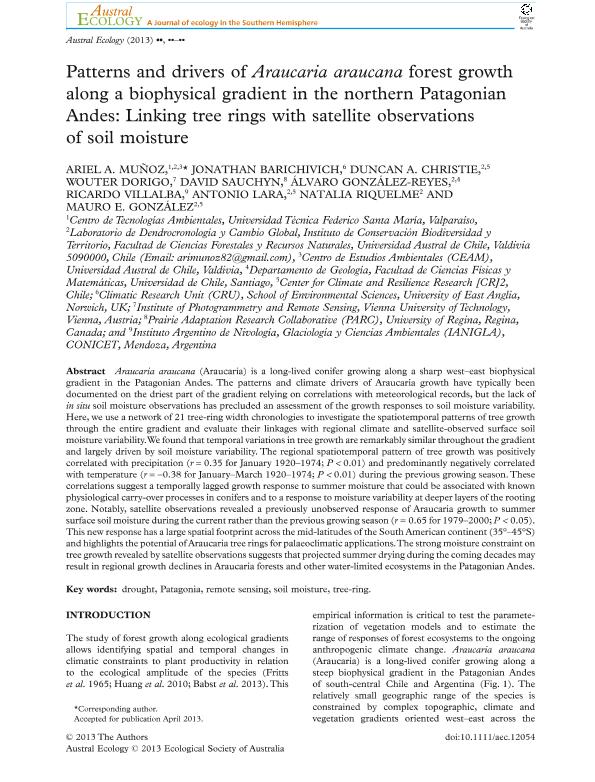Mostrar el registro sencillo del ítem
dc.contributor.author
Muñoz, Ariel A.
dc.contributor.author
Barichivich, Jonathan
dc.contributor.author
Christie, Duncan A.
dc.contributor.author
Dorigo, Wuoter
dc.contributor.author
Sauchyn, David
dc.contributor.author
Gonzalez Reyes, Alvaro
dc.contributor.author
Villalba, Ricardo

dc.contributor.author
Lara, Antonio
dc.contributor.author
Riquelme, Natalia
dc.contributor.author
González, Mauro
dc.date.available
2015-12-17T18:37:37Z
dc.date.issued
2013-06-13
dc.identifier.citation
Muñoz, Ariel A.; Barichivich, Jonathan; Christie, Duncan A.; Dorigo, Wuoter; Sauchyn, David; et al.; Patterns and drivers of Araucaria araucana forest growth along a biophysical gradient in the northern Patagonian Andes: Linking tree rings with satellite observations of soil moisture; Wiley Blackwell Publishing, Inc; Austral Ecology; 39; 2; 13-6-2013; 158-169
dc.identifier.issn
1442-9985
dc.identifier.uri
http://hdl.handle.net/11336/3014
dc.description.abstract
Araucaria araucana (Araucaria) is a long-lived conifer growing along a sharp west-east biophysical gradient in the Patagonian Andes. The patterns and climate drivers of Araucaria growth have typically been documented on the driest part of the gradient relying on correlations with meteorological records, but the lack of in situ soil moisture observations has precluded an assessment of the growth responses to soil moisture variability. Here, we use a network of 21 tree-ring width chronologies to investigate the spatiotemporal patterns of tree growth through the entire gradient and evaluate their linkages with regional climate and satellite-observed surface soil moisture variability. We found that temporal variations in tree growth are remarkably similar throughout the gradient and largely driven by soil moisture variability. The regional spatiotemporal pattern of tree growth was positively correlated with precipitation (r=0.35 for January 1920-1974; P<0.01) and predominantly negatively correlated with temperature (r=-0.38 for January-March 1920-1974; P<0.01) during the previous growing season. These correlations suggest a temporally lagged growth response to summer moisture that could be associated with known physiological carry-over processes in conifers and to a response to moisture variability at deeper layers of the rooting zone. Notably, satellite observations revealed a previously unobserved response of Araucaria growth to summer surface soil moisture during the current rather than the previous growing season (r=0.65 for 1979-2000; P<0.05). This new response has a large spatial footprint across the mid-latitudes of the South American continent (35°-45°S) and highlights the potential of Araucaria tree rings for palaeoclimatic applications. The strong moisture constraint on tree growth revealed by satellite observations suggests that projected summer drying during the coming decades may result in regional growth declines in Araucaria forests and other water-limited ecosystems in the Patagonian Andes.
dc.format
application/pdf
dc.language.iso
eng
dc.publisher
Wiley Blackwell Publishing, Inc

dc.rights
info:eu-repo/semantics/openAccess
dc.rights.uri
https://creativecommons.org/licenses/by-nc-sa/2.5/ar/
dc.subject
Drought
dc.subject
Patagonia
dc.subject
Remote Seising
dc.subject
Soil Moisture
dc.subject
Tree Ring
dc.subject.classification
Ciencias Medioambientales

dc.subject.classification
Ciencias de la Tierra y relacionadas con el Medio Ambiente

dc.subject.classification
CIENCIAS NATURALES Y EXACTAS

dc.title
Patterns and drivers of Araucaria araucana forest growth along a biophysical gradient in the northern Patagonian Andes: Linking tree rings with satellite observations of soil moisture
dc.type
info:eu-repo/semantics/article
dc.type
info:ar-repo/semantics/artículo
dc.type
info:eu-repo/semantics/publishedVersion
dc.date.updated
2016-03-30 10:35:44.97925-03
dc.journal.volume
39
dc.journal.number
2
dc.journal.pagination
158-169
dc.journal.pais
Reino Unido

dc.journal.ciudad
Londres
dc.description.fil
Fil: Muñoz, Ariel A.. Universidad Técnica Federico Santa María; Chile. Universidad Austral de Chile; Chile
dc.description.fil
Fil: Barichivich, Jonathan. University of East Anglia; Reino Unido
dc.description.fil
Fil: Christie, Duncan A.. Universidad Austral de Chile; Chile. Center for Climate and Resilience Research; Chile
dc.description.fil
Fil: Dorigo, Wuoter. Vienna University of Technology; Austria
dc.description.fil
Fil: Sauchyn, David. University of Regina. Prairie Adaptation Research Collaborative; Canadá
dc.description.fil
Fil: Gonzalez Reyes, Alvaro. Universidad Austral de Chile; Chile. Universidad de Chile; Chile
dc.description.fil
Fil: Villalba, Ricardo. Consejo Nacional de Investigaciones Científicas y Técnicas. Científico Tecnológico Mendoza. Instituto Argentino de Nivología, Glaciología y Ciencias Ambientales; Argentina
dc.description.fil
Fil: Lara, Antonio. Center for Climate and Resilience Research; Chile. Universidad Austral de Chile; Chile
dc.description.fil
Fil: Riquelme, Natalia. Universidad Austral de Chile; Chile
dc.description.fil
Fil: González, Mauro. Universidad Austral de Chile; Chile. Center for Climate and Resilience Research; Chile
dc.journal.title
Austral Ecology

dc.relation.alternativeid
info:eu-repo/semantics/altIdentifier/url/https://onlinelibrary.wiley.com/doi/10.1111/aec.12054
dc.relation.alternativeid
info:eu-repo/semantics/altIdentifier/doi/http://dx.doi.org/10.1111/aec.12054
Archivos asociados
